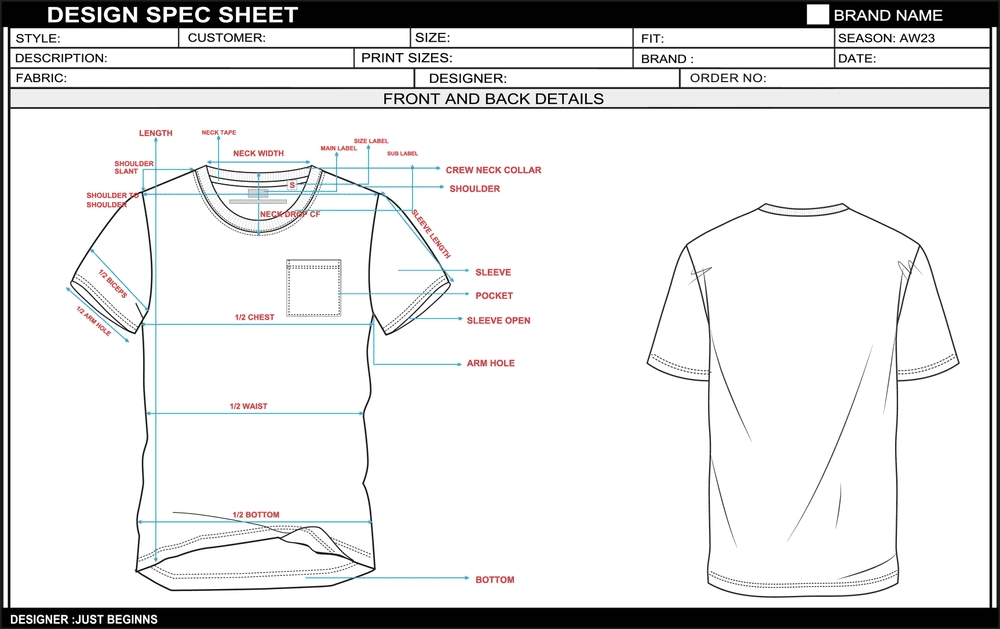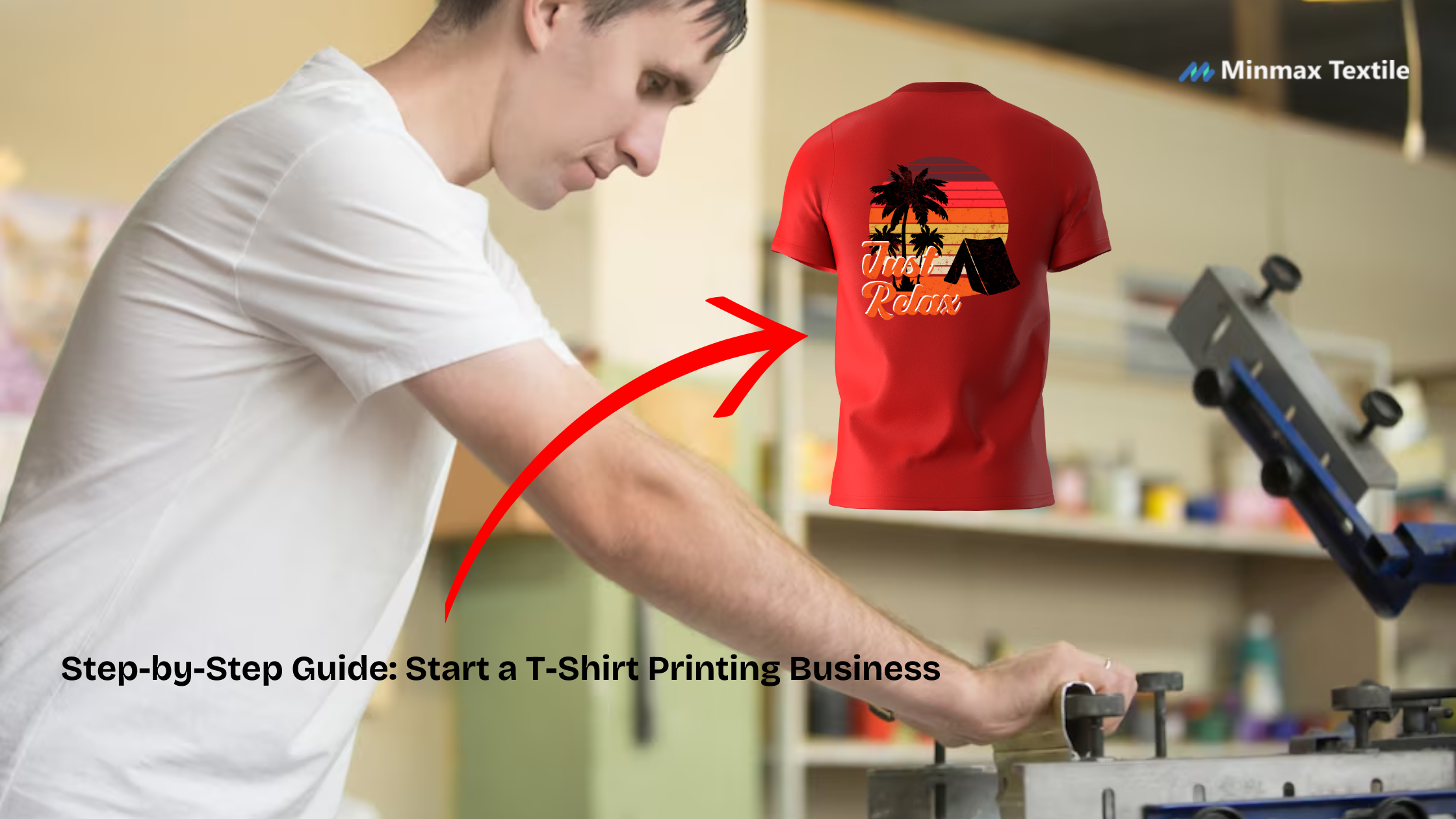T-shirts are a wardrobe staple, loved for their comfort and versatility and also making them a popular choice for clothing businesses. Whether you’re a sewing enthusiast eager to delve into garment making or someone looking to personalize their wardrobe, understanding basic t shirt pattern is crucial for creating comfortable and stylish products. This guide introduces the fundamental aspects of t-shirt patterns, covering various types such as crew neck, V-neck, and raglan. Each t-shirt consists of essential components: the body, sleeves, neckband, hemline, and seams. Creating a basic t-shirt pattern involves accurate measurements, drafting pattern pieces, adding seam allowances, and careful fabric cutting. The assembly process includes sewing shoulder seams, attaching the neckband and sleeves, sewing side seams, and hemming. Choosing the right fabric, testing fit, and experimenting with variations can help refine your patterns and lead to successful designs. Understanding these basics ensures the production of high-quality t-shirts that appeal to a wide market.
Why Learn Basic T-Shirt Patterns?
Mastering basic t-shirt patterns offers several advantages beyond creating custom-fit clothing:
- Customization: Design t-shirts that reflect your personal style, from fabric selection to adding unique details like pockets or embroidery.
- Cost Savings: Making your own t-shirts can be more economical than purchasing custom-fit options from stores.
- Skill Development: Enhance your sewing skills and understanding of garment construction, applicable to other clothing projects.
- Sustainability: Reduce your environmental impact by creating clothes that fit well and last longer, reducing the need for fast fashion purchases.
- Creativity: Experiment with different fabrics, colors, and designs to express your unique style through your wardrobe.
Understanding Different Types of T-Shirt Patterns
When it comes to t-shirt patterns, there’s a wide variety to choose from, each impacting the overall style, comfort, and fit of the garment.
Variations in Necklines
The neckline of a t-shirt significantly influences its appearance and comfort. Here are the most common variations:
- Crew Neck: A classic, round neckline that sits close to the neck, suitable for both casual and formal wear.
- V-Neck: Characterized by a V-shaped dip, adding a touch of elegance and flattering most body types.
- Scoop Neck: A deeper, U-shaped neckline that offers a relaxed and casual look, perfect for warmer weather or a laid-back style.
Choosing the right neckline depends on personal preference and the intended use of the t-shirt. A crew neck provides a timeless, versatile option, while a V-neck adds sophistication. Scoop necks are great for a casual, breezy look.
Sleeve Lengths
The sleeve length of a t-shirt affects its functionality and style. Consider these options:
- Short Sleeve: The most common sleeve length, ideal for warm weather and everyday wear.
- Long Sleeve: Provides more coverage and warmth, suitable for cooler climates or layering during transitional seasons.
- Raglan Sleeve: Features diagonal seams that extend from underarm to collarbone, often seen in sporty or casual wear.
Each sleeve length offers a distinct aesthetic and practicality. Short sleeves are versatile and timeless, long sleeves add warmth and are suitable for cooler weather, and raglan sleeves provide a sporty, modern look.
Fit and Silhouette
The fit and silhouette of a t-shirt determine how it drapes on the body. Consider these common options:
- Regular Fit: Offers a relaxed, comfortable fit that suits most body types.
- Slim Fit: Cut closer to the body for a sleek, modern look that enhances the silhouette.
- Oversized Fit: Provides a relaxed and casual vibe with extra room for comfort and style.
Choosing the right fit depends on personal preference and the intended use of the t-shirt. A regular fit is versatile and suitable for everyday wear, while a slim fit offers a more tailored appearance. Oversized fits are trendy and offer a relaxed, effortless style.
Materials and Fabric Choice
The choice of fabric plays a crucial role in the comfort, durability, and overall appearance of your t-shirt. Here are some popular fabrics used for t-shirts:
Common T-Shirt Fabrics
| Fabric Type |
Description |
| Cotton Jersey | Soft, breathable, and stretchy fabric that is comfortable for everyday wear. |
| Polyester Blend | Synthetic fabric known for its durability, wrinkle resistance, and moisture-wicking properties. |
| Linen | Lightweight and breathable fabric, ideal for warm weather due to its moisture-absorbing properties. |
| Organic Cotton | Environmentally-friendly option grown without synthetic pesticides or fertilizers. |
| Bamboo | Sustainable fabric with antibacterial properties and excellent moisture-wicking abilities. |
Choosing the right fabric depends on factors like climate, intended use, and personal preference. Cotton jersey is a popular choice for its comfort, while polyester blends offer durability and ease of care. Natural fibers like linen and organic cotton are excellent for eco-conscious consumers, providing breathability and comfort.
Tools and Equipment Needed
To start creating your own t-shirt patterns, you’ll need a set of basic sewing tools and equipment. Here’s what you’ll typically require:
Basic Sewing Tools
- Fabric Scissors: Sharp scissors dedicated to cutting fabric accurately.
- Measuring Tape: Essential for taking body measurements and ensuring accurate sizing.
- Pins and Needles: Used to hold fabric pieces together during sewing.
- Sewing Machine: A basic sewing machine for stitching seams and finishing edges efficiently.
- Thread: High-quality thread suitable for the fabric type and sewing machine.
- Iron and Ironing Board: Essential for pressing seams and achieving professional-looking finishes.
Advanced Tools for Precision
- Pattern Paper: Specialized paper for drafting and tracing patterns accurately.
- Rulers and French Curves: Tools for drawing straight lines and curves when drafting patterns.
- Rotary Cutter and Cutting Mat: Useful for cutting fabric pieces accurately, especially for intricate patterns.
- Serger (Optional): A serger or overlock machine for professional seam finishing and edge trimming.
Having the right tools ensures your t-shirt projects are precise and professionally finished. Invest in quality tools that suit your skill level and sewing goals, ensuring a smooth and enjoyable sewing experience.
Step-by-Step Guide to Creating a Basic T-Shirt Pattern
Now that you have an understanding of t-shirt styles, fabrics, and necessary tools, let’s dive into the process of creating a basic t-shirt pattern from scratch.
Taking Body Measurements
Before you begin drafting your t-shirt pattern, you’ll need accurate body measurements. Here’s how to take essential measurements:
- Chest: Measure around the fullest part of your chest, usually just under the armpits.
- Waist: Measure around the narrowest part of your waistline.
- Hips: Measure around the fullest part of your hips.
- Shoulder Width: Measure from the base of the neck (where the shoulder meets the neck) across to the shoulder joint.
- Sleeve Length: Measure from the shoulder joint down to where you want the sleeve to end.
- Shirt Length: Measure from the base of the neck down to where you want the t-shirt to end.
Record these measurements accurately, as they will serve as the basis for drafting your t-shirt pattern.
Drafting the Pattern
Drafting a basic t-shirt pattern involves creating templates for the front, back, sleeves, and neckline. Here’s a simplified overview of the process:
- Front and Back Panels: Use your chest, waist, and hip measurements to draw the outline of the front and back panels on pattern paper. Add seam allowances (typically 1/2 inch) around the edges for sewing.
- Sleeves and Neckline: Draft sleeves that match your sleeve length measurement and choose a neckline style (crew, v-neck, scoop) based on your preference. Ensure the neckline matches the width of your head to avoid stretching when putting on the t-shirt.
Cutting and Marking
Once your pattern is drafted, use fabric scissors to cut out the front, back, and sleeve panels from your chosen fabric. Transfer markings like darts, notches, and grainlines from the pattern paper to the fabric pieces using tailor’s chalk or fabric markers.
Sewing Techniques
Assemble your t-shirt using basic sewing techniques suitable for your fabric type and sewing machine. Here are key steps:
- Seam Allowances: Sew seams with the designated seam allowance, typically 1/2 inch, using a straight stitch on your sewing machine.
- Finishing Edges: Finish raw edges with a zigzag stitch or serger to prevent fraying and ensure durability.
- Hemming: Fold and press hems at the bottom of the t-shirt, sleeves, and neckline before sewing with a straight stitch or twin needle for a professional finish.
Experiment with different sewing techniques and finishes to achieve the look and fit you desire for your t-shirt.
Tips for Customization and Variations
Once you’ve mastered the basics of t-shirt patterns, you can customize your creations to suit your style and preferences. Here are some ideas for customization:
Adding Pockets or Embellishments
Enhance your t-shirt design by adding functional pockets or decorative embellishments like patches, embroidery, or appliques. Consider placement and size to complement the overall aesthetic of your t-shirt.
Modifying Sleeve Styles
Experiment with different sleeve styles to change the look and functionality of your t-shirt. Try cap sleeves, bell sleeves, or layered sleeves for a unique and personalized touch.
Experimenting with Hemlines
Explore different hemline options to alter the silhouette and style of your t-shirt. Choose from straight hems, curved hems, or asymmetrical hems to create visual interest and enhance fit.
Troubleshooting Common Issues
As you embark on your t-shirt making journey, you may encounter challenges. Here are some common issues and how to troubleshoot them:
Fitting Problems
If your t-shirt fits too tight or loose in certain areas, make adjustments to the pattern by adding or subtracting fabric at the seams. Use muslin or inexpensive fabric to test adjustments before cutting into your main fabric.
Pattern Adjustments
Fine-tune your t-shirt pattern based on feedback from fitting sessions. Make adjustments to neckline depth, sleeve length, or overall length to achieve a comfortable and flattering fit.
Fabric Handling Tips
Choose fabrics that are suitable for t-shirt patterns, such as jersey knits or cotton blends, to ensure ease of sewing and comfort when wearing. Pre-wash and press fabrics before cutting to prevent shrinkage and ensure accurate sizing.
Final Words
Creating your own basic t-shirt patterns opens up a world of creativity and customization. Whether you’re a beginner or seasoned sewer, mastering these foundational skills allows you to design t-shirts that fit your style, body, and values. Embrace the journey of sewing your own garments, and enjoy the satisfaction of wearing clothes made with your own hands.
Basic T-Shirt Pattern: A Beginner’s Step-by-Step Guide
What materials are best for making t-shirts?
Choosing the right fabric for your t-shirt depends on factors like comfort, durability, and style. Cotton jersey is a popular choice for its softness and breathability, while polyester blends offer durability and moisture-wicking properties. Natural fibers like organic cotton and bamboo are great for eco-conscious consumers.
Do I need special equipment to create t-shirt patterns?
While basic sewing tools like fabric scissors, measuring tape, and a sewing machine are essential, you may also benefit from tools like pattern paper, rulers, and a rotary cutter for precise pattern drafting. A serger or overlock machine can provide professional seam finishes, but it’s optional for basic t-shirt projects.
How do I adjust a t-shirt pattern for a better fit?
Achieving the perfect fit involves taking accurate body measurements and making adjustments to the pattern accordingly. Common adjustments include adding or reducing seam allowances, altering sleeve lengths, or adjusting neckline depths. Test adjustments with a muslin prototype before cutting into your main fabric.
What are some tips for sewing t-shirt necklines without stretching?
To prevent stretching when sewing t-shirt necklines, use a stretch stitch or a narrow zigzag stitch on your sewing machine. Support the neckline with stay tape or clear elastic while sewing to maintain shape and stability. Press gently with a low-heat iron to avoid flattening the fabric.
Can I customize my t-shirt pattern to include unique design elements?
Absolutely! Customizing your t-shirt pattern allows you to add personal touches like pockets, embroidery, or different sleeve styles. Experiment with hemlines, color blocking, or fabric textures to create one-of-a-kind t-shirts that reflect your individual style and creativity.





